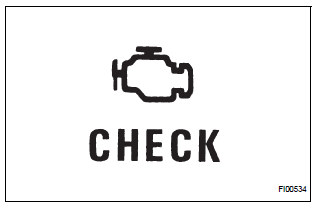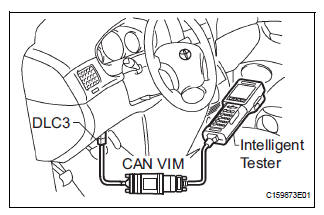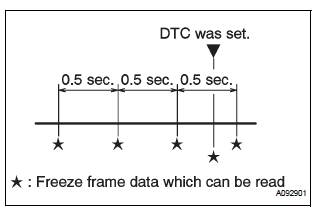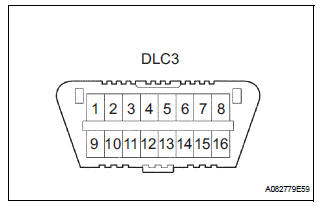Toyota Sienna Service Manual: Diagnosis system
1. DESCRIPTION

(a) When troubleshooting OBD II vehicles, the only difference from the usual troubleshooting procedure is to connect an OBD II scan tool complying with SAE J1987 or a intelligent tester to the vehicle, and read off various data output from the vehicle's ECM.
(b) OBD II regulations require that the vehicle's onboard computer illuminate the Malfunction Indicator Lamp (MIL) on the instrument panel when the computer detects a malfunction in the computer itself or in the drive system components which affect the vehicle emissions. In addition to illuminating the MIL when a malfunction is detected, the applicable DTCs prescribed by SAE J2012 are recorded in the ECM memory (See page AX-35).
If the malfunction does not occur in 3 consecutive trips, the MIL goes off but the DTCs remain in the ECM memory.
(c) To check the DTCs, connect the OBD II scan tool or intelligent tester to the DLC3 of the vehicle. The OBD II scan tool or intelligent tester also enables you to erase the DTCs and check freeze frame data and various forms of engine data (For operating instructions, see the instruction book).
(d) The DTCs include SAE controlled codes and Manufacturer controlled codes. SAE controlled codes must be set as prescribed by the SAE, while Manufacturer controlled codes can be set freely by a manufacturer within the prescribed limits (See page AX-35).

(e) The diagnosis system operates in "normal mode" during the normal vehicle use. In normal mode, "2- trip detection logic" is used to ensure accurate detection of malfunction. "Check mode" is also available to technicians as an option. In check mode, "1-trip detection logic" is used for simulating malfunction symptoms and increasing the system's ability to detect malfunctions, including intermittent malfunction.
(f) *2 trip detection logic: When a malfunction is first detected, the malfunction is temporarily stored in the ECM memory (1st trip). If the ignition switch is turned off and then turned to the ON position again, and same malfunction is detected again, the MIL will illuminate.

(g) Freeze frame data records the engine conditions (fuel system, calculated load, engine coolant temperature, fuel trim, engine speed, vehicle speed, etc.) when a malfunction is detected. When troubleshooting, freeze frame data can help determine if the vehicle was running or stopped, if the engine was warmed up or not, if the air/fuel ratio was Lean or Rich, and other data from the time the malfunction occurred.
(h) The intelligent tester records freeze frame data in five different instance: 1) 3 times before the DTC is set, 2) once when the DTC is set, and 3) once after the DTC is set. These data can be used to simulate the vehicle's condition around the time when the malfunction occurred. The data may help find the cause of the malfunction, or judge if the DTC is being caused by temporary malfunction or not.
2. INSPECT THE DLC3

(a) The vehicle's ECM uses ISO 15765-4 for communication. The terminal arrangement of the DLC3 complies with SAE J1962 and matches the ISO 15765-4 format.
Terminals of DLC3

| CAUTION: *: Before measuring the resistance, leave the vehicle as is for at least 1 minute and do not operate the ignition switch, any other switches or the doors. |
HINT: If your display shows UNABLE TO CONNECT TO VEHICLE when you have connected the cable of the OBD II scan tool or intelligent tester to the DLC3, turned the ignition switch to the ON position and operated the scan tool, there is a problem on the vehicle side or tool side.
- If the communication is normal when the tool is connected to another vehicle, inspect the DLC3 on the original vehicle.
- If the communication is still impossible when the tool is connected to another vehicle, the problem is probably in the tool itself, so consult the Service Department listed in the tool's instruction manual.
3. CHECK BATTERY VOLTAGE
(a) Measure the battery voltage.
Battery voltage: 11 to 14 V
If voltage is below 11 V, replace the battery before proceeding
4. CHECK MIL
(a) The MIL comes on when the ignition switch is turned to the ON position and the engine is not running.
HINT: If the MIL does not light up, troubleshoot the combination meter
(b) When the engine is started, the MIL should go off. If the lamp remains on, it means that the diagnosis system has detected a malfunction or abnormality in the system.
 Terminals of ecm
Terminals of ecm
1. Ecm
Hint:
each ecm terminal's standard voltage is shown in the
table below.
In the table, first follow the information under "condition".
Look under "symbols (terminal no. ...
 Dtc check / clear
Dtc check / clear
1. DTC CHECK (NORMAL MODE)
NOTICE:
When the diagnostic system is switched from the
normal mode to the check mode, all the DTCs and
freeze frame data recorded in the normal mode will
...
Other materials:
Short in Rear Curtain Shield Squib LH Circuit
DTC B1635/87 Short in Rear Curtain Shield Squib LH Circuit
DESCRIPTION
The rear curtain shield squib LH circuit consists of the center airbag sensor
assembly and the curtain
shield airbag assembly LH.
The circuit instructs the SRS to deploy when deployment conditions are met.
DTC B1635/87 ...
Engine
GENERAL MAINTENANCE
HINT:
Inspect these items when the engine is cold.
1. INSPECT DRIVE BELT
HINT:
(See page EM-6)
2. REPLACE SPARK PLUGS
HINT:
(See page IG-8)
3. INSPECT AIR FILTER
(a) Remove the air filter.
(b) Visually check that the air filter is not excessively
damaged or oily ...
Data list / active test
1. READ DATA LIST
HINT:
Using the intelligent tester's DATA LIST allows switch,
actuator and other item values to be read without
removing any parts. Reading the DATA LIST early in
troubleshooting is one way to save time.
Connect the intelligent tester with CAN VIM to the
DLC3.
&n ...
